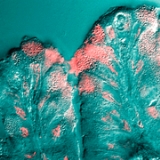
Mucus
Overview
In vertebrate
s, mucus (adjectival form: "mucous") is a slippery secretion produced by, and covering, mucous membrane
s. Mucous fluid is typically produced from mucous cells found in mucous glands. Mucous cells secrete products that are rich in glycoproteins and water. Mucous fluid may also originate from mixed glands, which contain both serous and mucous cells. It is a viscous colloid
containing antiseptic
enzymes (such as lysozyme
), immunoglobulins, inorganic salts
, proteins such as lactoferrin
, and glycoprotein
s known as mucins that are produced by goblet cell
s in the mucous membranes and submucosal glands
.
Vertebrate
Vertebrates are animals that are members of the subphylum Vertebrata . Vertebrates are the largest group of chordates, with currently about 58,000 species described. Vertebrates include the jawless fishes, bony fishes, sharks and rays, amphibians, reptiles, mammals, and birds...
s, mucus (adjectival form: "mucous") is a slippery secretion produced by, and covering, mucous membrane
Mucous membrane
The mucous membranes are linings of mostly endodermal origin, covered in epithelium, which are involved in absorption and secretion. They line cavities that are exposed to the external environment and internal organs...
s. Mucous fluid is typically produced from mucous cells found in mucous glands. Mucous cells secrete products that are rich in glycoproteins and water. Mucous fluid may also originate from mixed glands, which contain both serous and mucous cells. It is a viscous colloid
Colloid
A colloid is a substance microscopically dispersed evenly throughout another substance.A colloidal system consists of two separate phases: a dispersed phase and a continuous phase . A colloidal system may be solid, liquid, or gaseous.Many familiar substances are colloids, as shown in the chart below...
containing antiseptic
Antiseptic
Antiseptics are antimicrobial substances that are applied to living tissue/skin to reduce the possibility of infection, sepsis, or putrefaction...
enzymes (such as lysozyme
Lysozyme
Lysozyme, also known as muramidase or N-acetylmuramide glycanhydrolase, are glycoside hydrolases, enzymes that damage bacterial cell walls by catalyzing hydrolysis of 1,4-beta-linkages between N-acetylmuramic acid and N-acetyl-D-glucosamine residues in a peptidoglycan and between...
), immunoglobulins, inorganic salts
Inorganic ions
For ions in inorganic compounds see ionic compounds.Inorganic ions in animals and plants are ions necessary for vital cellular activity. In body tissues, ions are also known as electrolytes, essential for the electrical activity needed to support muscle contractions and neuron activation...
, proteins such as lactoferrin
Lactoferrin
Lactoferrin , also known as lactotransferrin , is a multifunctional protein of the transferrin family. Lactoferrin is a globular glycoprotein with a molecular mass of about 80 kDa that is widely represented in various secretory fluids, such as milk, saliva, tears, and nasal secretions...
, and glycoprotein
Glycoprotein
Glycoproteins are proteins that contain oligosaccharide chains covalently attached to polypeptide side-chains. The carbohydrate is attached to the protein in a cotranslational or posttranslational modification. This process is known as glycosylation. In proteins that have segments extending...
s known as mucins that are produced by goblet cell
Goblet cell
Goblet cells are glandular simple columnar epithelial cells whose sole function is to secrete mucin, which dissolves in water to form mucus. They use both apocrine and merocrine methods for secretion....
s in the mucous membranes and submucosal glands
Submucosal glands
Submucosal glands can refer to:*Esophageal glands, the submucosal glands of the esophagus.*Brunner's glands, the submucosal glands of the duodenum.*Submucosal glands in the upper airways of mammals....
.

